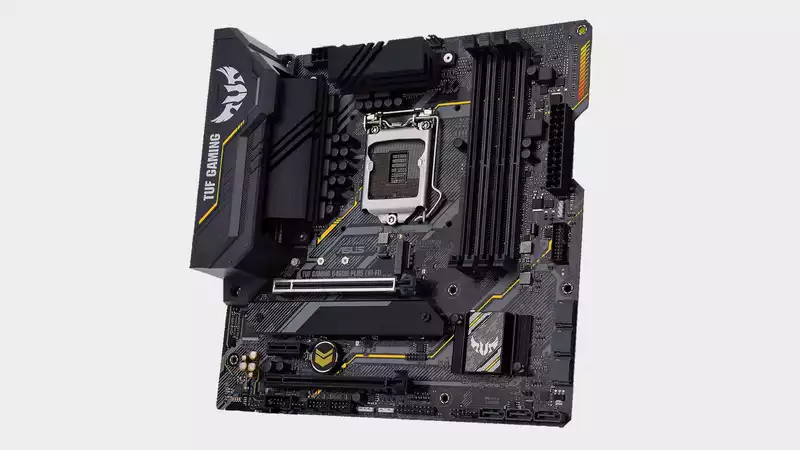The Asus TUF Gaming B460M-Plus Wi-Fi was tested following the affordable ASRock and MSI B460 boards Asus' TUF products have evolved from the original Sabertooth boards to their own sub-brand. the TUF brand support and components are characterized by their distinctive yellowish aesthetics and are also produced by many peripheral manufacturers.
The B460M TUF retails for US$130. This is slightly more expensive than the excellent MSI B460M Mortar Wi-Fi, which we also featured. We are big fans of this budget board, so something has to be pulled out of the bag for this Asus to be our number one choice for the B460.
The TUF B460M Plus is a Micro-ATX board, like many of the affordable new B460 motherboards that support the Intel Comet Lake chip. And like many TUF products, it does not emulate the Studio 54 laser light show that many users will find attractive; it has RGB and ARGB headers for those who need a flashy effect.
It also has Wi-Fi 6, but it's not the most feature-packed board we've seen; Asus also went with the Intel I219-V gigabit LAN instead of the 2.5Gb Realtek that many competing boards have. However, 2.5Gb would be better suited for large file transfers to and from a NAS. Perhaps Asus decided to omit a few odds and ends to include Wi-FI at this price. For example, there is no Type-C USB header on the front.
Curiously, Asus has included a heatsink in only one of the two M.2 slots. Placing a fast NVMe M.2 drive under a hot GPU requires cooling, so why not put a heatsink in both? 6 SATA ports and ALC1200 audio, but no S/PDIF if you're into home cinema. 4-pin There are four fan headers, but these are really minimal. However, the quality of Asus' fan control is commendable.
The TUF B460M has a 6+1+1 phase VRM, driven by a single 8-pin power connector. The heatsink is adequate, but no more than that; the TUF B460M will power any 10th generation CPU, but realistically, if you frequently run a Core i9 10900K under heavy load, you should opt for Asus' TUF Z490 Plus. We would stick with the TUF B460M with its 65W CPU and less stringent power limits.
The rear I/O is basic. As seen on many other B460 boards, there are only six USB ports. We understand that many people use the connectors on the front of the case, but adding two USB 2.0 ports on the back would not add substantially to the cost. The chipset already supports up to 12 USB 2.0 ports. Display connectivity, meanwhile, is a bright spot with DP 1.4, HDMI 1.4b, and DVI-D ports. In other words, the TUF Gaming B460M-Plus is compatible with a wide range of displays when using 10th generation integrated graphics. Of course, this is not relevant when using discrete graphics cards.
The TUF B460M-Plus performs as expected; the ASRock B460 Steel Legend is faster, but the difference is small as one would expect from a modern motherboard; the B460 memory limitations apply to all manufacturers, but once again the emphasis I think it is worthwhile. Intel, why do you handicap us so much? Give us a DDR4-3200 option, even if it is considered "overclocking."
Unfortunately, Intel is not known for such altruism.
The TUF B460M BIOS is comprehensive, but users unfamiliar with the Asus BIOS may face a slightly steeper learning curve compared to some boards. Also,
the Asus B460M BIOS is comprehensive, but users unfamiliar with the Asus BIOS may have a slightly steeper learning curve compared to some boards.
Asus calls this Asus Performance Enhancement (yes, APE). We do not have a 65W CPU on hand for testing, but we know it works. This is actually a very simple adjustment, and if you have a CPU that can take advantage of it, you can see a performance boost there. However, as mentioned, the VRM on the TUF B460M-Plus is not world-beating, so you will need proper airflow to cool the heatsink, especially when faced with the power limitations of a boosted i7 or i9 CPU.
The Asus TUF Gaming B460M WIFI is a solid and capable board, but at this price it faces stiff competition, especially from the superior MSI B460M Mortar WIFI. This board has a better feature list and VRM and is priced a few dollars less.
That doesn't mean Asus is bad. It doesn't. It's a great, sophisticated package. It's suitable for a low-end i3 or i5 CPU, add a decent GPU, and if you're interested in wireless networking, it will serve you well.
.

Comments